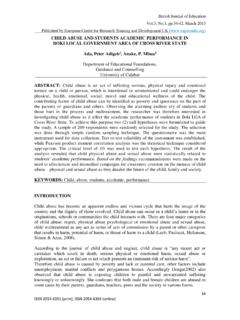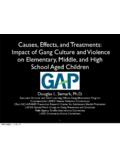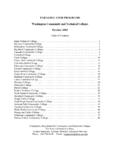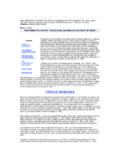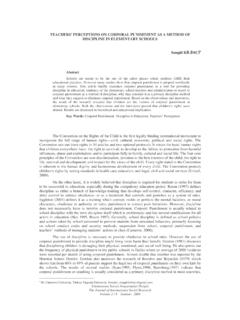Transcription of All sample proposals were prepared by Grants West, which ...
1 Grants West Lightsville School District received $387,000 in grant funding as a result of this grant proposal. It was prepared by Grants West, which has raised $165 million for nonprofit groups over the past ten years. To learn more about us, including our contact information, see websites at (serving nonprofits based in Colorado) and (serving nonprofits based in southern California). Note that we only work for nonprofits based inside the United States. We lack the expertise to help organizations in other countries. The proposal was funded by the Department of Education s 21st Century Community Learning Center program. This document is a modified format of the actual application, and does not include budget information or attachments that were submitted with the proposal. The name of the school and school district have been changed to protect privacy, but the content is identical to the material that was submitted. 1. NEED FOR THE PROJECT Families who live in northwest Lightsville faces serious challenges, including poverty, crime, unemployment, and low educational attainment.
2 One Jefferson Elementary neighborhood has one of the ten highest child poverty rates in Colorado (1990 US Census). Close to 40% of high school students at Lightsville High School, the feeder school for Jefferson students, drop out of school. The target area for this proposal is served by other federal programs such as Head Start, Family Preservation, Welfare to Work and Weed and Seed. The following information describing poverty rates and economic problems that face Northwest Lightsville is for background purposes only, as the proposal is not designed to directly create economic opportunities that will eliminate poverty. Certain elements of the proposal, specifically adult education, may provide families with tools to escape poverty. The proposed program does directly target student achievement, adult education, crime, substance abuse prevention, healthy families, and early education. 2 Jefferson Elementary Demographic Profile Enrollment by Ethnicity 1998-99 1999-2000 Total Enrollment 958 929 Hispanic/Latino African American White Native American Asian Limited English Proficiency POVERTY (background information only; not a focus area for proposal) More than 77% of Jefferson Elementary students are eligible for free/reduced breakfasts and lunches (740 of 958 students).
3 In two of the census tracts within school boundaries, one-third of the population is in poverty (the poverty rate for school age children in census tract 78 is ). The Lightsville Housing Authority conducted a recent study of the people in public housing, and found that were female head-of-households, 57% earned $4,800 a year or less. According to a 1999 projection by InfoUSA, 20% of households in zip code 00010 -- which encompasses Jefferson Elementary School -- earn less than $15,000 annually (CACI/InfoUSA, 1999). More than 72% of Jefferson students participate in the federal free/reduced lunch program (LPS only tracks participation rates; the actual eligibility rate may be higher). EMPLOYMENT/ECONOMIC (background information; not a focus area for proposal) Though the overall unemployment rate in 1990 for Lightsville as a whole was just , three of the four census tracts comprising Northwest Lightsville experienced unemployment at approximately triple that number.
4 Lightsville has suffered several economic setbacks. In 1995, the Lowry Air Force Base and Stapleton Airport closed; Fitzsimmons Army Medical Center closed in 1998. Directly and indirectly these closures have led to a huge loss of jobs and negative residual impact on the local economy and community businesses. Redevelopment plans for Lowry, Fitzsimmons and Stapleton are all in their early stages, and it is hard to know right now if those plans will ever make up for the economic loss Lightsville suffered in the past five years. Colfax Avenue, a main boulevard in the proposed service area, has long been a notorious haven for drug trafficking and prostitution, and hosts businesses such as pawnshops, temporary day labor employment agencies, adult-oriented businesses, dangerous bars, and check cashing sites. 3 Census Tract Approx. % of tract in Jefferson Elementary Boundaries Poverty Rate Poverty Rate Children between 6 and 18 % of Adults 25+ with High School Diploma/ GED Unemploy- ment Rate (1990) Median House-hold Income # of persons who Do Not Speak English "Very Well" 73 33% $16,275 293 79 100% 20,270 187 FOCUS AREA 1: STUDENT ACHIVEMENT Last year s graduation rate at feeder Lightsville High School was ; at the alternative school William Henry High less than 23% of students graduated.
5 The transiency rate at Jefferson exceeded 114% in 1997 (compared to the District s elementary school average of ). The chart below shows how well students at Jefferson met LPS content proficiencies, compared with statewide averages. Jefferson Students meeting proficiencies Grade Level Writing Math Reading Jefferson 2nd Grade 33 60 36 District Average: 2nd Grade 58 84 62 Jefferson 5th Grade 42 43 50 District Average: 5th Grade 56 62 65 Jefferson students perform poorly compared to other Colorado students on the Colorado Statewide Assessment Program. Only 21% of Jefferson s 3rd grade students met proficiencies on the reading test or a 46% lower proportionately than other schools statewide. Only 18% of Jefferson s 4th graders were proficient in reading, compared to a statewide average of 60%. Additionally, only 5% of 4th graders were proficient on the writing test. 4 Colorado Statewide Assessment Program (CSAP) Results % Jefferson students meeting CSAP proficiencies Statewide Comparison Grade Level Reading Grade Level Reading Writing Grade Level math 3rd Grade: Jefferson 21% 4th Grade: Jefferson 18% 5% 5th Grade: Jefferson 12% 3rd Grade: Statewide 67% 4th Grade: Statewide 60% 33% 5th Grade: Statewide 47% On the Riverside Math Performance Assessment, only 8% of Jefferson s 5th Graders met proficiencies scoring in just the 10th percentile.
6 Jefferson 2nd and 5th graders also fared poorly on the District Writing Assessment. Grade Level % Proficient: Holistic Writing % Proficient: Analytic Writing Jefferson 2nd Graders 28 32 All LPS 2nd Graders 33 40 Jefferson 5th Graders 9 30 All LPS 5th Graders 34 46 Addressing Student Achievement: The proposed center will incorporate tutoring and academic enrichment activities that support student achievement in the classroom, and help students meet proficiencies required by Lightsville Public Schools and the State of Colorado. Lightsville Public Schools has established a promotion policy requiring that students being promoted from second to third grade meet the performance requirements in a least two of the three cornerstone areas of reading, writing and number sense. Students classified as 2B (3rd grade students who did not meet two of the three performance requirements) will receive extra help. 5 FOCUS AREA 2: JUVENILE CRIME AND SUBSTANCE abuse A 1995 risk assessment by the City of Lightsville's Build a Generation project found a sharp increase in juvenile delinquency and crime (a 73% increase in juvenile arrest rates for substance abuse in a five year period; a 1312% increase in gang activity during a three year period).
7 Washington County has a juvenile crime arrest rate of 324 per 1000 (KidsCount, 1998). The Washington County juvenile crime arrest rate and violent arrest rate are more than double the Colorado average. Two years ago, Jefferson Elementary had the highest suspension rate of any elementary school in of Colorado. On an Lightsville Public Schools annual survey of student drug use, the percentage of 5th and 7th graders who have admitted to being multi-drug users and heavy alcohol consumers has increased from approximately 1% in 1993 to close to 5% in 1998. Of 7th graders, the percentage admitting to moderate involvement (occasional use of marijuana, alcohol or other drugs) has increased from 10% in 1993 to 24% in 1998. Of 11th graders surveyed, the average age they said they first got drunk was years and the average age of first marijuana use was years. Two years ago, the Lightsville Police Department conducted a study of crimes near Jefferson Elementary, determining that 527 crimes occurred within a 1000 foot radius of the school.
8 Crime is a fact of life that children growing up in North Lightsville may come to view as normal. The Lightsville Police Department has told Lightsville Public Schools that peak youth crime hours are between 3pm and 6pm. Organized recreation/cultural activities offered by community agencies have been found to decrease substance use and delinquency by providing an incentive for youth who are disengaged from schools to be involved in school activities. This creates an opportunity to provide more structured intervention activities that target substance abuse and other high risk behaviors (CSAP Technical Report 13: A Review of Alternatives Activities and Alternatives Programs in Youth-Oriented Prevention, 1996). Addressing Juvenile Crime and Substance abuse : The proposed afterschool enrichment activities creatively incorporate and stress lessons of conflict resolution, substance abuse prevention, and nonviolence. Program hours operate during a peak youth crime period.
9 Focus area 3: Adult education and family stability Many adults who do not speak English or have low educational attainment live in the target area. According to the census, approximately one-quarter of adults in the area do not have a GED. At Jefferson, the percentage of Limited English Proficiency (LEP) students has increased from in 1994-95 to in 1999-2000. A 1997 study by the Denver Post found that "the immigration tidal wave of the 1990s has hit Lightsville Public Schools harder than any other district in Colorado." Other family issues are of concern. The rate of child abuse in Washington County is 39% higher than the state average. Zip code 00010, which includes most of the target area and neighboring 00011 -- had 1,208 child protection cases in 1996, or the largest number of cases in any area of Madison County. In 1995, 51% of all teen pregnancies in Lightsville occurred within the same 6 two zip codes (Lightsville has ten zip codes). Based on need, Lightsville Mental Health Corporation has placed a therapist on-site at West.
10 00010 is also one of only three Denver area zip codes that qualifies for federal infant mortality prevention funding. Addressing Adult Education and Family Stability: Adult programs will include subjects such as computers, financial planning, parenting classes, English as a Second Language, and other related areas. FOCUS AREA 4: Early education programs Within a two mile radius of the highest need area, there are only 7 child care centers serving a capacity of 452 children, and 29 family child care homes serving a total capacity of 228 children. In a more affluent area of South Lightsville, the capacity for child care within a two mile radius is nearly five times as high for center-based care, and double for family child care homes. Demand has increased so substantially for quality preschool that Lightsville Head Start now has a 100 family waiting list. Addressing Early Education Programs: After 3pm, Jefferson Elementary School s preschool room is vacant.


